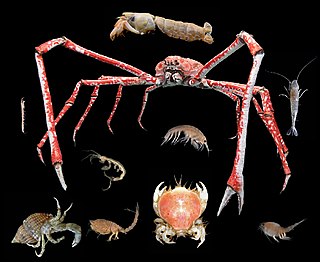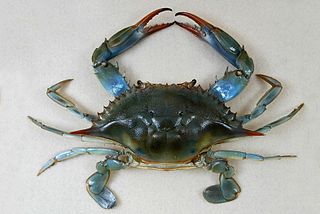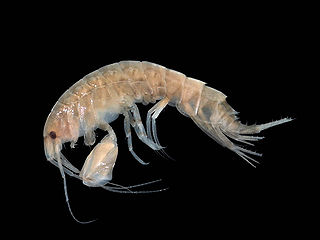
Uropods are posterior appendages found on a wide variety of crustaceans. They typically have functions in locomotion.

Uropods are posterior appendages found on a wide variety of crustaceans. They typically have functions in locomotion.
Uropods are often defined as the appendages of the last body segment of a crustacean. [1] An alternative definition suggested by Frederick R. Schram restricts the term to those structures arising from the segment before the anal segment (the segment which carries the anus). [1] Under this latter definition, the appendages of the anal segment are caudal rami, which are analogous to uropods. [1]
Uropods are typically biramous – comprising an endopod and an exopod. The exopod is typically the larger, and may be divided in two by a transverse suture known as the diaeresis. [2] [3] The uropods may work in concert with the telson to form a "tail fan". [4]

The Caridea, commonly known as caridean shrimp, are an infraorder of shrimp within the order Decapoda. They are found widely around the world in both fresh and salt water.

Malacostraca is the largest of the six classes of crustaceans, containing about 40,000 living species, divided among 16 orders. Its members, the malacostracans, display a great diversity of body forms and include crabs, lobsters, crayfish, shrimp, krill, woodlice, amphipods, mantis shrimp and many other, less familiar animals. They are abundant in all marine environments and have colonised freshwater and terrestrial habitats. They are segmented animals, united by a common body plan comprising 20 body segments, and divided into a head, thorax, and abdomen.

Ostracods, or ostracodes, are a class of the Crustacea, sometimes known as seed shrimp. Some 70,000 species have been identified, grouped into several orders. They are small crustaceans, typically around 1 mm (0.039 in) in size, but varying from 0.2 to 30 mm in the case of Gigantocypris. Their bodies are flattened from side to side and protected by a bivalve-like, chitinous or calcareous valve or "shell". The hinge of the two valves is in the upper (dorsal) region of the body. Ostracods are grouped together based on gross morphology. While early work indicated the group may not be monophyletic; and early molecular phylogeny was ambiguous on this front, recent combined analyses of molecular and morphological data found support for monophyly in analyses with broadest taxon sampling

A carapace is a dorsal (upper) section of the exoskeleton or shell in a number of animal groups, including arthropods, such as crustaceans and arachnids, as well as vertebrates, such as turtles and tortoises. In turtles and tortoises, the underside is called the plastron.

Isopoda is an order of crustaceans that includes woodlice and their relatives. Isopods live in the sea, in fresh water, or on land. All have rigid, segmented exoskeletons, two pairs of antennae, seven pairs of jointed limbs on the thorax, and five pairs of branching appendages on the abdomen that are used in respiration. Females brood their young in a pouch under their thorax.

Maxillopoda is a diverse class of crustaceans including barnacles, copepods and a number of related animals. It does not appear to be a monophyletic group, and no single character unites all the members.

The decapod crustacean, such as a crab, lobster, shrimp or prawn, is made up of 20 body segments grouped into two main body parts, the cephalothorax and the pleon (abdomen). Each segment may possess one pair of appendages, although in various groups these may be reduced or missing. They are, from head to tail:

Leptostraca is an order of small, marine crustaceans. Its members, including the well-studied Nebalia, occur throughout the world's oceans and are usually considered to be filter-feeders. It is the only extant order in the subclass Phyllocarida. They are believed to represent the most primitive members of their class, the Malacostraca, and first appear in the fossil record during the Cambrian period.

Eucarida is a superorder of the Malacostraca, a class of the crustacean subphylum, comprising the decapods, krill, Amphionides and Angustidontida. They are characterised by having the carapace fused to all thoracic segments, and by the possession of stalked eyes.

The superorder Peracarida is a large group of malacostracan crustaceans, having members in marine, freshwater, and terrestrial habitats. They are chiefly defined by the presence of a brood pouch, or marsupium, formed from thin flattened plates (oostegites) borne on the basalmost segments of the legs. Peracarida is one of the largest crustacean taxa and includes about 12,000 species. Most members are less than 2 cm (0.8 in) in length, but the largest is probably the giant isopod which can reach 76 cm (30 in).

Eumalacostraca is a subclass of crustaceans, containing almost all living malacostracans, or about 40,000 described species. The remaining subclasses are the Phyllocarida and possibly the Hoplocarida. Eumalacostracans have 19 segments. This arrangement is known as the "caridoid facies", a term coined by William Thomas Calman in 1909. The thoracic limbs are jointed and used for swimming or walking. The common ancestor is thought to have had a carapace, and most living species possess one, but it has been lost in some subgroups.
Traditionally, the Myodocopa and Podocopa have been classified as subclasses within the class Ostracoda, although there is some question about how closely related the two groups actually are. The Myodocopa are defined by possession of a poorly calcified carapace, and 8–9 articles in the exopod of the second antenna. The ventral margin of the carapace is not concave, and the valves do not overlap to a great extent.
The Halocyprida is one of the two orders within the Myodocopa, in turn a subclass of the ostracods. Like their relatives in the order Myodocopida, they have a long exopod on the second antenna. However, unlike myodocopids, their fifth appendage is leg-like rather than modified for feeding, their seventh limb is reduced or absent, and they have no lateral eyes. The group is primarily planktonic. There are two suborders: Halocypridina and Cladocopina.
Polycopidae is a family of marine ostracods. Its members are related to animals in the suborder Halocypridina, but are sufficiently distinct to be placed in their own sub-order, Cladocopina. There is speculation that a separate order may be warranted. The genera in the family differ from the other suborder, Halocypridina, in several features: the central adductor muscle scars are in a triangular or half-rosette pattern, they lack sixth and seventh limbs, and the maxilla has both an exopod and endopod.

Diastylidae is one of the eight most commonly recognised families of crustaceans of the order Cumacea. They are marine creatures especially common around the 30th parallel north.
Ascothoracida is a small group of crustaceans, comprising around 100 species. They are found throughout the world, and are parasites on cnidarians and echinoderms.

Asellota is a suborder of isopod crustaceans found in marine and freshwater environments. Roughly one-quarter of all marine isopods belong to this suborder. Members of this suborder are readily distinguished from other isopods by their complex copulatory apparatus. Other characteristics include six-jointed antennal peduncle, the styliform uropods, the fusion of pleonites 5, 4 and sometimes 3 to the pleotelson, and absence of the first pleopod in females.

A chela, also named claw, nipper, or pincer, is a pincer-like organ terminating certain limbs of some arthropods. The name comes from Greek (χηλή) through New Latin. The plural form is chelae. Legs bearing a chela are called chelipeds. Another name is claw because most chelae are curved and have a sharp point like a claw.

Crustaceans form a large, diverse arthropod taxon which includes such familiar animals as crabs, lobsters, crayfish, shrimps, prawns, krill, woodlice, and barnacles. The crustacean group is usually treated as a class under subphylum Mandibulata and because of recent molecular studies it is now well accepted that the crustacean group is paraphyletic, and comprises all animals in the Pancrustacea clade other than hexapods. Some crustaceans are more closely related to insects and other hexapods than they are to certain other crustaceans.
An oostegite is a large, flexible plate-like flap extending medially from the coxae of the pereiopods in some female crustaceans. It forms part of the marsupium or brood pouch of members of the superorder Peracarida, from the class Malacostraca.